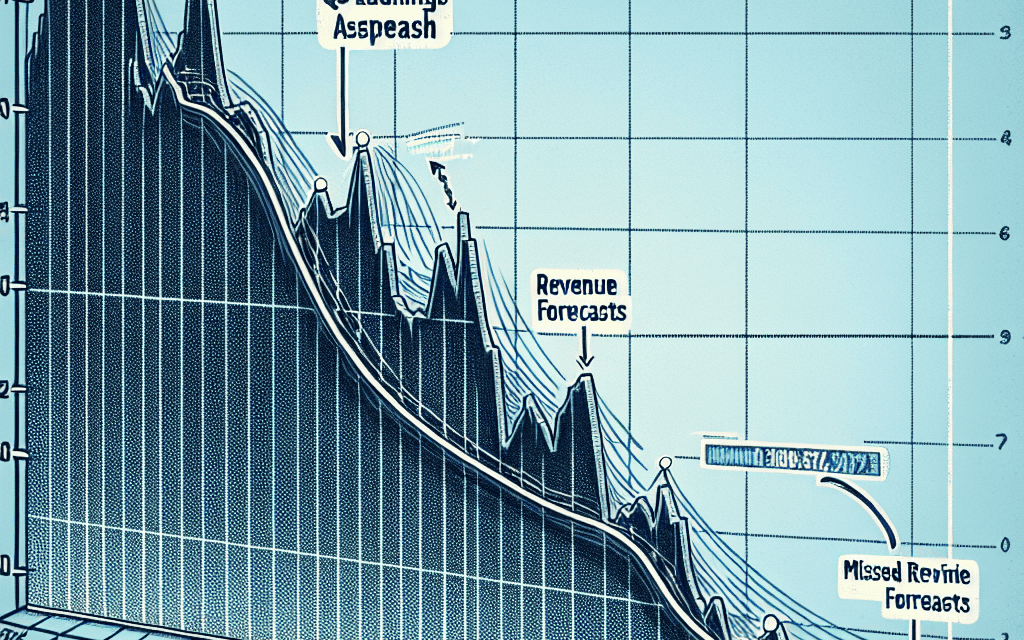“IBM’s Earnings Shine, But Revenue Clouds Investor Confidence.”
Introduction
In the third quarter, IBM reported earnings that exceeded analysts’ expectations, yet the company’s stock experienced a decline due to revenue figures that fell short of forecasts. Despite demonstrating robust profitability, the tech giant’s inability to meet revenue projections raised concerns among investors about its growth trajectory. This discrepancy between earnings and revenue highlights the challenges IBM faces in balancing profitability with expansion in a competitive market. The market’s reaction underscores the importance of revenue growth as a key indicator of a company’s long-term potential, even when earnings performance is strong.
Analysis Of IBM’s Q3 Earnings: Surpassing Expectations But Missing Revenue Forecasts
In the third quarter of 2023, IBM reported earnings that surpassed analysts’ expectations, yet the company’s stock experienced a decline due to revenue figures that fell short of forecasts. This juxtaposition of positive earnings against disappointing revenue highlights the complex dynamics at play within the tech giant’s financial performance. As investors and analysts dissect the results, it becomes evident that while IBM is making strides in certain areas, challenges remain that could impact its future trajectory.
To begin with, IBM’s earnings per share (EPS) exceeded market predictions, showcasing the company’s ability to manage costs effectively and optimize its operations. This achievement is particularly noteworthy given the competitive landscape of the technology sector, where companies are constantly vying for market share and innovation leadership. The better-than-expected EPS suggests that IBM has been successful in implementing strategies to enhance profitability, possibly through cost-cutting measures or improved operational efficiencies. However, despite this positive development, the company’s revenue figures did not meet analysts’ expectations, which has raised concerns among investors.
The revenue shortfall can be attributed to several factors, including slower-than-anticipated growth in certain business segments. For instance, IBM’s traditional hardware and infrastructure services have faced headwinds as the industry shifts towards cloud computing and software solutions. While IBM has made significant investments in its cloud and cognitive software divisions, these areas have yet to fully offset the decline in its legacy businesses. This transition period poses a challenge for IBM, as it must balance the need to innovate and expand its cloud offerings while managing the decline in its traditional revenue streams.
Moreover, the competitive pressures from other tech giants in the cloud computing space cannot be overlooked. Companies like Amazon Web Services, Microsoft Azure, and Google Cloud continue to dominate the market, making it difficult for IBM to capture a larger share. This intense competition necessitates that IBM not only invests in cutting-edge technology but also differentiates its offerings to attract and retain customers. The revenue miss in the third quarter underscores the urgency for IBM to accelerate its transformation efforts and strengthen its position in the cloud market.
In addition to these challenges, macroeconomic factors have also played a role in IBM’s revenue performance. Global economic uncertainties, fluctuating currency exchange rates, and geopolitical tensions can impact the company’s international operations and sales. As a multinational corporation, IBM is particularly susceptible to these external influences, which can affect its ability to achieve revenue targets. Therefore, while the company has demonstrated resilience in its earnings, it must navigate these broader economic conditions to sustain growth.
In conclusion, IBM’s third-quarter earnings report presents a mixed picture of the company’s financial health. The positive earnings surprise indicates that IBM is making progress in improving its profitability, yet the revenue miss highlights ongoing challenges in its business transformation. As the company continues to pivot towards cloud computing and software solutions, it must address competitive pressures and external economic factors to achieve sustainable growth. Investors and analysts will be closely monitoring IBM’s strategic initiatives and market performance in the coming quarters to assess its ability to overcome these hurdles and deliver long-term value.
Factors Contributing To IBM’s Stock Decline Post-Q3 Earnings
IBM’s recent financial performance has been a topic of considerable interest, particularly following the release of its third-quarter earnings report. Despite surpassing earnings expectations, IBM’s stock experienced a decline, a phenomenon that can be attributed to several interrelated factors. Understanding these elements provides insight into the complexities of market reactions and investor sentiment.
To begin with, IBM’s earnings per share (EPS) exceeded analysts’ predictions, showcasing the company’s ability to manage costs effectively and maintain profitability. This achievement, however, was overshadowed by a revenue figure that fell short of forecasts. The revenue miss is a critical factor in the stock’s decline, as it raises concerns about the company’s growth trajectory and its ability to generate sales in a competitive technology landscape. Investors often prioritize revenue growth as a key indicator of a company’s future potential, and any shortfall in this area can lead to negative market reactions.
Moreover, the revenue miss highlights challenges in IBM’s core business segments. The company has been undergoing a significant transformation, focusing on cloud computing and artificial intelligence to drive future growth. While these areas have shown promise, the transition has not been without hurdles. The slower-than-expected growth in these segments suggests that IBM is still grappling with the complexities of shifting its business model. This ongoing transformation, while necessary for long-term success, can create uncertainty in the short term, contributing to investor apprehension.
In addition to these internal factors, external market conditions have also played a role in IBM’s stock decline. The technology sector, in general, has been experiencing volatility due to macroeconomic factors such as inflationary pressures and interest rate hikes. These broader economic conditions can impact investor confidence, leading to more cautious investment strategies. As a result, even companies with strong earnings reports can see their stock prices affected by the overall market sentiment.
Furthermore, competitive pressures cannot be overlooked. IBM operates in a highly competitive industry, with major players like Amazon, Microsoft, and Google dominating the cloud computing space. The intense competition requires IBM to continuously innovate and differentiate its offerings, a task that is both challenging and resource-intensive. Any perceived lag in keeping pace with competitors can lead to concerns about IBM’s market position and future prospects, influencing stock performance.
Another contributing factor is the market’s reaction to IBM’s guidance for the coming quarters. Investors closely scrutinize forward-looking statements to gauge a company’s future performance. If the guidance is perceived as conservative or indicates potential challenges ahead, it can lead to a negative reaction in the stock market. In IBM’s case, any cautious outlook provided by the company may have amplified concerns about its ability to achieve sustained growth.
In conclusion, IBM’s stock decline following its Q3 earnings report is a multifaceted issue. While the company demonstrated strong earnings performance, the revenue miss, coupled with internal transformation challenges, external economic conditions, competitive pressures, and market perceptions of future guidance, all contributed to the decline. These factors underscore the complexity of market dynamics and the importance of a holistic approach to evaluating a company’s financial health and growth potential. As IBM continues to navigate its strategic transformation, investors will be closely monitoring its progress and adaptability in an ever-evolving technological landscape.
Market Reaction To IBM’s Q3 Performance: A Closer Look
In the wake of IBM’s third-quarter earnings report, the market’s reaction has been notably tepid, with the company’s stock experiencing a decline despite earnings surpassing expectations. This paradoxical response can be attributed to a nuanced interplay of factors that investors are weighing carefully. While IBM’s earnings per share exceeded analysts’ predictions, the company’s revenue fell short of forecasts, creating a mixed picture that has left investors cautious.
To begin with, IBM’s earnings per share for the third quarter came in higher than anticipated, a positive indicator of the company’s operational efficiency and cost management strategies. This performance suggests that IBM has been successful in optimizing its resources and controlling expenses, which is a commendable achievement in a challenging economic environment. However, the enthusiasm generated by this earnings beat was tempered by the company’s revenue figures, which did not meet market expectations. This shortfall in revenue has raised concerns about IBM’s growth trajectory and its ability to generate top-line expansion in a competitive tech landscape.
The revenue miss can be attributed to several factors, including slower-than-expected growth in certain segments of IBM’s business. For instance, while the company’s cloud computing division has been a focal point of its strategic pivot, the growth in this area did not fully offset declines in other traditional segments. This highlights the ongoing challenge IBM faces in transforming its business model and achieving a balanced growth across its diverse portfolio. Moreover, the competitive pressures from other tech giants in the cloud space have intensified, making it imperative for IBM to innovate and differentiate its offerings to capture a larger market share.
In addition to these operational challenges, macroeconomic factors have also played a role in shaping investor sentiment. The broader economic environment, characterized by inflationary pressures and geopolitical uncertainties, has created a backdrop of caution among investors. These external factors have contributed to a more conservative outlook on tech stocks, including IBM, as market participants assess the potential impact on future earnings and revenue growth.
Furthermore, the market’s reaction to IBM’s Q3 performance underscores the importance of meeting or exceeding revenue expectations in addition to earnings. In the tech industry, where growth potential is a key driver of stock valuations, revenue figures are closely scrutinized as an indicator of a company’s ability to expand its market presence and capitalize on emerging opportunities. As such, IBM’s revenue miss has overshadowed its earnings beat, leading to a decline in its stock price as investors reassess their positions.
In conclusion, the market’s response to IBM’s third-quarter performance reflects a complex interplay of factors, including operational challenges, competitive pressures, and macroeconomic conditions. While the company’s ability to exceed earnings expectations is a positive sign, the revenue shortfall has raised questions about its growth prospects and strategic direction. As IBM continues to navigate this evolving landscape, it will be crucial for the company to address these concerns and demonstrate its capacity to drive sustainable growth. Investors, in turn, will be closely monitoring IBM’s efforts to enhance its competitive positioning and deliver on its long-term objectives.
Revenue Shortfall: What It Means For IBM’s Future Growth

IBM’s recent financial performance has sparked considerable discussion among investors and analysts alike. Despite the company surpassing earnings expectations in the third quarter, its stock has experienced a decline, primarily due to a revenue shortfall that has raised questions about its future growth trajectory. This development underscores the complex dynamics at play within IBM’s business model and the broader technology sector.
To begin with, IBM’s ability to exceed earnings expectations is a testament to its operational efficiency and cost management strategies. The company has been successful in optimizing its expenses, which has allowed it to deliver better-than-anticipated profits. This achievement is particularly noteworthy given the challenging economic environment and the competitive pressures within the technology industry. However, while earnings provide a snapshot of a company’s profitability, revenue figures offer a more comprehensive view of its market position and growth potential.
In this context, IBM’s revenue miss is a cause for concern. The shortfall suggests that the company is facing challenges in expanding its market share and driving top-line growth. Several factors could be contributing to this situation. For instance, the rapid pace of technological change means that IBM must continuously innovate to stay ahead of its competitors. Additionally, the company’s traditional business segments, such as mainframe computing, are experiencing slower growth, which may be impacting overall revenue performance.
Moreover, IBM’s strategic pivot towards cloud computing and artificial intelligence, while promising, is still in the early stages of development. The company has made significant investments in these areas, aiming to capture a larger share of the burgeoning digital transformation market. However, the transition from legacy systems to cloud-based solutions is complex and requires time to yield substantial returns. As a result, the revenue generated from these new initiatives may not yet be sufficient to offset declines in IBM’s traditional business lines.
Furthermore, the broader economic landscape also plays a crucial role in shaping IBM’s revenue prospects. Global economic uncertainties, such as inflationary pressures and geopolitical tensions, can impact corporate IT spending, which in turn affects IBM’s sales. Companies may delay or reduce their technology investments in response to economic volatility, thereby influencing IBM’s ability to achieve its revenue targets.
Looking ahead, IBM’s management must address these challenges to ensure sustainable growth. This involves not only continuing to innovate and expand its cloud and AI offerings but also effectively communicating the value of these solutions to potential customers. Additionally, strategic partnerships and acquisitions could play a pivotal role in enhancing IBM’s competitive position and driving revenue growth.
In conclusion, while IBM’s recent earnings performance is commendable, the revenue shortfall highlights the need for a strategic reassessment. The company must navigate a complex landscape of technological change, economic uncertainty, and competitive pressures to achieve its growth objectives. By focusing on innovation, strategic investments, and market expansion, IBM can position itself for long-term success. However, investors and stakeholders will be closely monitoring the company’s progress in these areas, as they are critical determinants of IBM’s future growth trajectory.
Investor Sentiment: How IBM’s Q3 Results Impacted Market Confidence
IBM’s third-quarter earnings report has sparked a complex reaction among investors, as the company’s financial performance presented a mixed bag of results. While IBM managed to surpass earnings expectations, its revenue figures fell short of forecasts, leading to a decline in its stock price. This outcome has prompted a reevaluation of investor sentiment, as market participants weigh the implications of these results on the company’s future prospects.
To begin with, IBM’s earnings per share exceeded analysts’ predictions, showcasing the company’s ability to maintain profitability despite challenging market conditions. This achievement can be attributed to IBM’s strategic focus on high-margin businesses, such as cloud computing and artificial intelligence, which have been pivotal in driving its earnings growth. The company’s efforts to streamline operations and reduce costs have also contributed to its improved bottom line. However, the positive impact of these factors was overshadowed by the disappointing revenue figures, which failed to meet market expectations.
The revenue shortfall can be largely attributed to slower-than-anticipated growth in IBM’s key business segments. While the cloud computing division has been a significant growth driver, its performance in the third quarter did not match the robust expansion seen in previous periods. This deceleration has raised concerns among investors about the sustainability of IBM’s growth trajectory in an increasingly competitive landscape. Furthermore, the company’s traditional hardware and infrastructure services businesses continue to face headwinds, as clients increasingly shift towards more agile and cost-effective solutions offered by competitors.
In light of these developments, investor sentiment has been notably impacted. The decline in IBM’s stock price reflects a cautious outlook among market participants, who are now reassessing the company’s ability to navigate the evolving technological landscape. The mixed financial results have also reignited discussions about IBM’s long-term strategic direction and its capacity to adapt to the rapid pace of innovation in the tech industry. As a result, some investors may adopt a wait-and-see approach, opting to monitor IBM’s progress in executing its strategic initiatives before making further investment decisions.
Moreover, the broader market environment has also played a role in shaping investor sentiment towards IBM. With economic uncertainties and geopolitical tensions influencing global markets, investors are increasingly prioritizing companies with strong growth prospects and resilient business models. In this context, IBM’s mixed results have heightened scrutiny over its competitive positioning and ability to deliver consistent revenue growth.
Despite these challenges, it is important to recognize that IBM remains a formidable player in the technology sector, with a rich history of innovation and a diverse portfolio of offerings. The company’s ongoing investments in emerging technologies and strategic partnerships underscore its commitment to staying at the forefront of industry developments. However, to regain investor confidence, IBM will need to demonstrate tangible progress in capturing new market opportunities and driving sustainable revenue growth.
In conclusion, IBM’s third-quarter earnings report has had a nuanced impact on investor sentiment, as the company’s earnings beat was overshadowed by a revenue miss. This has led to a decline in its stock price and prompted a reevaluation of its growth prospects. As investors navigate the complexities of the current market environment, IBM’s ability to execute its strategic initiatives and adapt to industry changes will be crucial in shaping future market confidence.
Comparing IBM’s Q3 Earnings With Industry Peers
In the third quarter of 2023, IBM reported earnings that exceeded analysts’ expectations, yet its stock experienced a decline due to revenue figures that fell short of forecasts. This mixed financial performance has prompted investors and analysts to compare IBM’s results with those of its industry peers, seeking to understand the broader implications for the technology sector. As we delve into this comparison, it becomes evident that while IBM’s earnings per share (EPS) demonstrated resilience, the revenue shortfall highlights challenges that are not unique to IBM but are shared across the industry.
To begin with, IBM’s EPS for Q3 surpassed market expectations, showcasing the company’s ability to manage costs effectively and maintain profitability. This achievement is particularly noteworthy given the current economic climate, characterized by inflationary pressures and supply chain disruptions. However, despite this positive earnings performance, IBM’s revenue did not meet analysts’ projections, raising concerns about the company’s growth trajectory. This revenue miss can be attributed to several factors, including slower-than-anticipated growth in key segments such as cloud computing and artificial intelligence, areas where IBM has been investing heavily.
In contrast, some of IBM’s industry peers have reported more balanced results, with both earnings and revenue meeting or exceeding expectations. For instance, companies like Microsoft and Amazon have continued to demonstrate robust growth in their cloud services divisions, capitalizing on the increasing demand for digital transformation solutions. These companies have successfully leveraged their extensive cloud infrastructure and service offerings to capture a larger market share, thereby driving both top-line and bottom-line growth. This contrast highlights the competitive landscape in which IBM operates, where agility and innovation are crucial for sustaining growth.
Moreover, the broader technology sector has been experiencing a shift in market dynamics, with an increasing emphasis on subscription-based models and recurring revenue streams. Companies that have successfully transitioned to these models have generally fared better in terms of revenue stability and investor confidence. IBM, while making strides in this direction, still faces challenges in fully capitalizing on these opportunities. The company’s ongoing transformation efforts, including its focus on hybrid cloud and AI, are steps in the right direction, but the pace of change may need to accelerate to keep up with more nimble competitors.
Furthermore, the macroeconomic environment continues to play a significant role in shaping the financial performance of technology companies. Rising interest rates and geopolitical tensions have introduced additional layers of complexity, affecting investment decisions and consumer spending patterns. In this context, IBM’s revenue miss can also be seen as a reflection of broader market uncertainties that are impacting the entire sector. However, it is important to note that IBM’s strong earnings performance suggests a level of resilience that could serve the company well in navigating these challenges.
In conclusion, while IBM’s Q3 earnings exceeded expectations, the revenue shortfall has raised questions about its growth prospects relative to industry peers. The comparison with companies like Microsoft and Amazon underscores the importance of strategic agility and innovation in the technology sector. As IBM continues its transformation journey, the ability to adapt to changing market dynamics and capitalize on emerging opportunities will be critical. Despite the current challenges, IBM’s strong earnings performance provides a foundation upon which the company can build as it seeks to enhance its competitive position in the industry.
Strategic Implications Of IBM’s Q3 Financial Results
IBM’s third-quarter financial results have presented a mixed bag of outcomes, with earnings surpassing expectations but revenue falling short of forecasts. This duality in performance has strategic implications for the company, as it navigates the complexities of a rapidly evolving technological landscape. The earnings report, which initially seemed promising, has led to a decline in IBM’s stock, underscoring the nuanced challenges the company faces.
To begin with, IBM’s ability to exceed earnings expectations highlights its operational efficiency and cost management strategies. The company has been focusing on streamlining its operations and optimizing its workforce, which has evidently paid off in terms of profitability. This focus on efficiency is crucial as IBM continues to transition from its traditional hardware and infrastructure services to more lucrative areas such as cloud computing and artificial intelligence. The earnings beat suggests that IBM is successfully managing its resources to maintain profitability during this transition.
However, the revenue miss indicates that IBM is still grappling with the challenge of generating sufficient top-line growth. Despite its efforts to pivot towards high-growth areas, the company has not yet fully capitalized on these opportunities. The shortfall in revenue can be attributed to several factors, including intense competition in the cloud computing space from giants like Amazon Web Services and Microsoft Azure. Additionally, the global economic environment, marked by uncertainties and fluctuating demand, has also played a role in tempering IBM’s revenue growth.
The strategic implications of these financial results are significant. IBM must continue to innovate and differentiate its offerings to capture a larger share of the cloud and AI markets. This requires not only technological advancements but also strategic partnerships and acquisitions that can bolster its capabilities and market presence. Furthermore, IBM needs to enhance its go-to-market strategies to better align with customer needs and preferences, ensuring that its solutions are not only cutting-edge but also accessible and relevant to its target audience.
Moreover, the decline in IBM’s stock following the earnings announcement reflects investor concerns about the company’s growth trajectory. While profitability is essential, investors are increasingly focused on growth potential, particularly in high-tech sectors. IBM’s challenge lies in convincing the market that it can achieve sustainable growth while maintaining its profitability. This involves a delicate balance of investing in innovation and managing costs, a task that requires strategic foresight and agile execution.
In light of these challenges, IBM’s leadership must also consider the broader industry trends and macroeconomic factors that could impact its performance. The ongoing digital transformation across industries presents both opportunities and threats, as companies seek to modernize their IT infrastructure and adopt new technologies. IBM’s ability to position itself as a leader in this transformation will be critical to its long-term success.
In conclusion, IBM’s Q3 financial results underscore the strategic challenges and opportunities the company faces as it seeks to redefine itself in a competitive and dynamic market. While the earnings beat is a testament to its operational strengths, the revenue miss highlights the need for continued innovation and strategic alignment. As IBM navigates this complex landscape, its ability to adapt and evolve will determine its future trajectory and its standing in the global technology arena.
Q&A
1. **What were IBM’s Q3 earnings results?**
IBM’s Q3 earnings surpassed expectations, indicating better-than-anticipated profitability.
2. **How did IBM’s revenue perform in Q3?**
IBM’s revenue missed forecasts, suggesting lower-than-expected sales or revenue generation.
3. **What was the market reaction to IBM’s Q3 earnings report?**
Despite the earnings beat, IBM’s stock declined, reflecting investor concerns or disappointment.
4. **Why did IBM’s stock decline despite strong earnings?**
The stock decline could be attributed to the revenue miss, overshadowing the positive earnings.
5. **What were analysts’ expectations for IBM’s Q3 revenue?**
Analysts had set higher revenue forecasts that IBM failed to meet.
6. **Did IBM provide any guidance for future quarters?**
The report may have included guidance, but the focus on revenue miss could have affected investor sentiment.
7. **What sectors or products contributed to IBM’s revenue miss?**
Specific sectors or products underperformed, leading to the overall revenue shortfall.
Conclusion
IBM’s stock decline, despite surpassing Q3 earnings expectations, highlights investor concerns over its revenue shortfall. While the company demonstrated strong earnings performance, the inability to meet revenue forecasts suggests underlying challenges in its business operations or market conditions. This discrepancy between earnings and revenue may indicate issues such as slower growth in key segments, competitive pressures, or macroeconomic factors affecting sales. Consequently, the market’s reaction underscores the importance of revenue growth as a critical indicator of long-term financial health and investor confidence.





